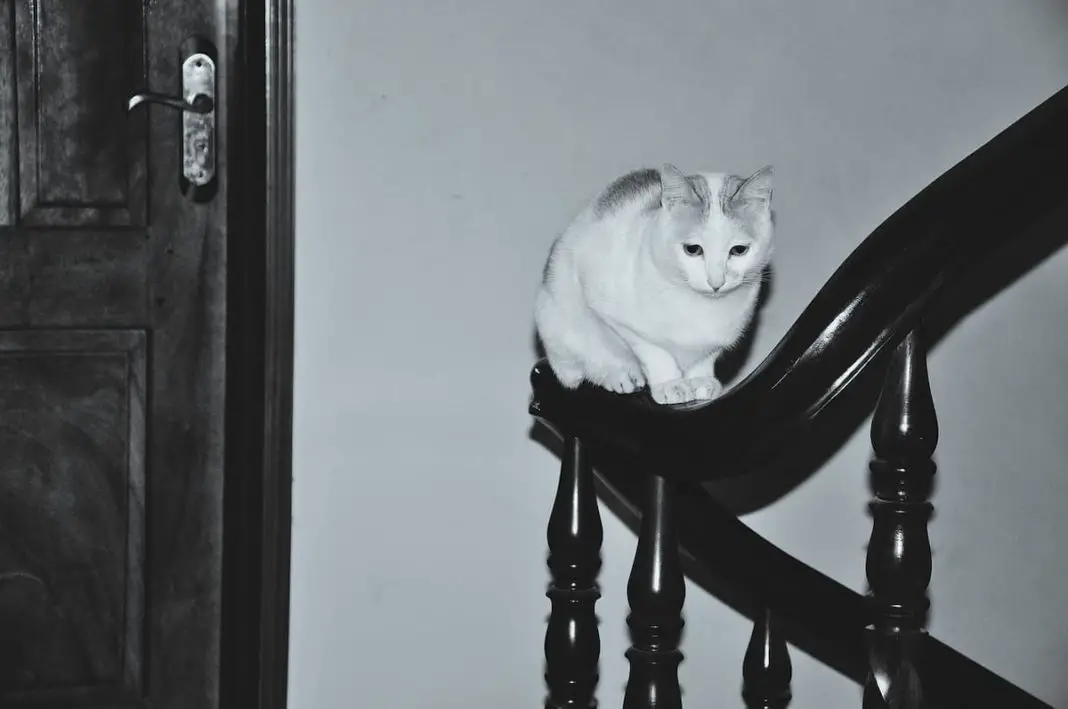How To Keep Cats Downstairs And Out Of Bedrooms
While we like our cats to explore our homes, there can be times when it becomes necessary to keep your cat from having access to different parts of the house. In this case, how do you keep a cat from going upstairs? Read on as we’ll cover ways to keep your cat from constantly getting upstairs.
It’s possible to keep cats away from certain areas in your home, like your bedroom, or a baby’s room, by using different methods like pet deterrent spray. More natural deterrents like orange peels, lavender, and citrus which emit scents that cats don’t like can also become useful. Other deterrents that can be used include placing double-stick tape, tinfoil, or even chicken wire or mesh on the stairs of your house. These types of materials have unpleasant textures that cats will always try to avoid.
Keeping Your Cat Out Of Your Bedroom At Night
Many cat owners prefer to keep their cats out of their bedrooms. Yes, we love our cats, however, we also need our sleep and privacy too. Like you, we don’t want our cats bothering us as we’re trying to sleep, especially when the cat decides that it wants to eat at 4 a.m.
In many cases, if the owner has allergies, the allergy symptoms can be reduced by keeping your bedroom free of cats and, more specifically, cat hair. Keeping baby rooms is another common space that many people would like to keep cat free.
So, what’s the best way to keep cats out of your bedroom at night? Your cat likely wants to be with you and doesn’t understand that you don’t really want to be with them while being in your bedroom. So, what are the downsides of this?

How To Keep A Cat Out Of Your Bedroom?
There’re a few humane ways to repel a cat from your bedroom door that doesn’t associate the unpleasant event with you:
Electronic Cat Repellents
These are recommended by many cat parents as they seem to work well for keeping a cat from a certain area. These repellent products often spray air whenever your cat approaches it. You can put it on the floor in front of your bedroom door and once your cat approaches, the device’s motion sensor detects goes of releasing a burst of air. These types of repellents don’t hurt cats, although they won’t like it.
Installing A Pet Gate At The Bottom Of The Stairs
A standard 22” baby gate across the front of the stairs isn’t necessarily terrifying for cats, especially when you take into consideration a cat can easily clear 5′ fences.
Using pet gates that are 34” can seem a bit more daunting and completely impassable for more senior, obese, or arthritic cats.
To make sure the gate keeps non-agile cats from getting through:
- Ensure the bars are far enough apart that a slender cat can’t squeeze through (with a slippery texture that cats can’t scale).
- Remove any items like boxes or furniture from around the gate that can serve as stepping stones to the gate.
- Tighten the tension mounts, keeping the gate from tipping over with the weight.
- When you need to pass by the gate, never step over the gate as your cat is watching. A towering fortress may seem far less risky to jump if it sees that over — not just through — is an option.
Set Up A Motion-Detecting Spray Deterrent At The Bottom Of The Stairs
A water bottle spritz, a jingling can, or a loud ‘No!’ may trigger a relentless cat to rethink its options. However, unless you monitor your cat 24/7, the living room, for example, will occasionally be unguarded,’ such as when you sleep, leave the house, or even clock out’ of cat duty.
Angling a motion-detecting spray deterrent around the foot of the stairs will help to keep the area off-limits. All it takes is an unexpected puff of compressed air (or citrus-scented liquid) to spook a cat or overpower its sensitive olfactory receptors.
You need to make sure that you don’t install the deterrent without expecting a backlash, as many of these motion detectors have a 3′ reach and just 80-100 spritzes apiece, so make sure that it won’t set off as your cat struts pass the bottom of the stairs.
Using Positive Reinforcement Training
When it comes to training a cat, using positive reinforcement is the only truly successful way to handle it in the long term. Positive reinforcement training focuses on rewarding good behavior rather than punishing bad behavior.
It’s normal for cats to be standoffish at times, which is why you need to associate yourself with positivity. By punishing a cat, they may eventually associate you with negative behaviors and become nervous around you or scared of you in the future. If the cat associates you with treats or loving pets, then they won’t fear you.
Positive training is vital for naturally skittish cats or for cats that have been rescued and may have had to endure unpleasant experiences in the past. When training your cat, always be compassionate and gentle.
Giving Your Cat Alternative Options
One form of positive training is to give your cat an alternative option to going upstairs. If they’re keen on trying to get upstairs, try to replicate the thing they’re looking for downstairs.
For example, if your cat likes to chew up your houseplants in a bedroom, try growing catnip in a room downstairs. Cats usually love catnip, compared to other plants, so they’ll likely be attracted to it more often.
If your cat loves a certain pillow in the bedroom, consider sacrificing the pillow and leaving it in a room downstairs. Or simply buy a similar pillow or cat bed that your cat will enjoy laying on.
Training Your Cat To Stay Downstairs
Unfortunately, keeping your cat out from going upstairs is a multi-step project that you will have to approach strategically. Training your cat can take some time.
You’ll need to be persistent and analyse if what you’re doing is working or if you need to skip a step or change things up. To successfully train your cat, you can try following the steps below.
I should note that while these steps worked for other cats doesn’t mean they’ll work for yours. Every cat is different.
Step #1
Start off by being realistic and lowering your expectations, as it takes some time and persistence.
Step #2
Set up a cat repellent, like either of the ones mentioned above. This may be cat training spray, natural deterrents like orange peels or a spray-on repellent near the bottom of the stairs. Try choosing something that’ll work, regardless if you’re at home or not.
Step #3
When you’re present, try distracting your cat from going upstairs. Try calling it, scratching the floor, or start playing with a toy. Whatever works best at grabbing its attention.
Step #4
Reward the cat when it chooses to not use the stairs. Once redirecting your cat’s attention successfully, and it doesn’t go near the stairs – reward it immediately with a treat or by petting it.
Step #5
Try to make the cat’s life cosier downstairs. By getting a cat house, boxes, cat trees or whatever you think your cat will appreciate the most will help to enrich their life downstairs. If the rest of your house is fun and comfy for the cat, it’ll feel less of a need to go upstairs.
Step #6
Play with your cat to keep it busy. If you want to keep the cat downstairs all the time, where you want him to be, you’ll need to fill its day by playing with it and petting it.








